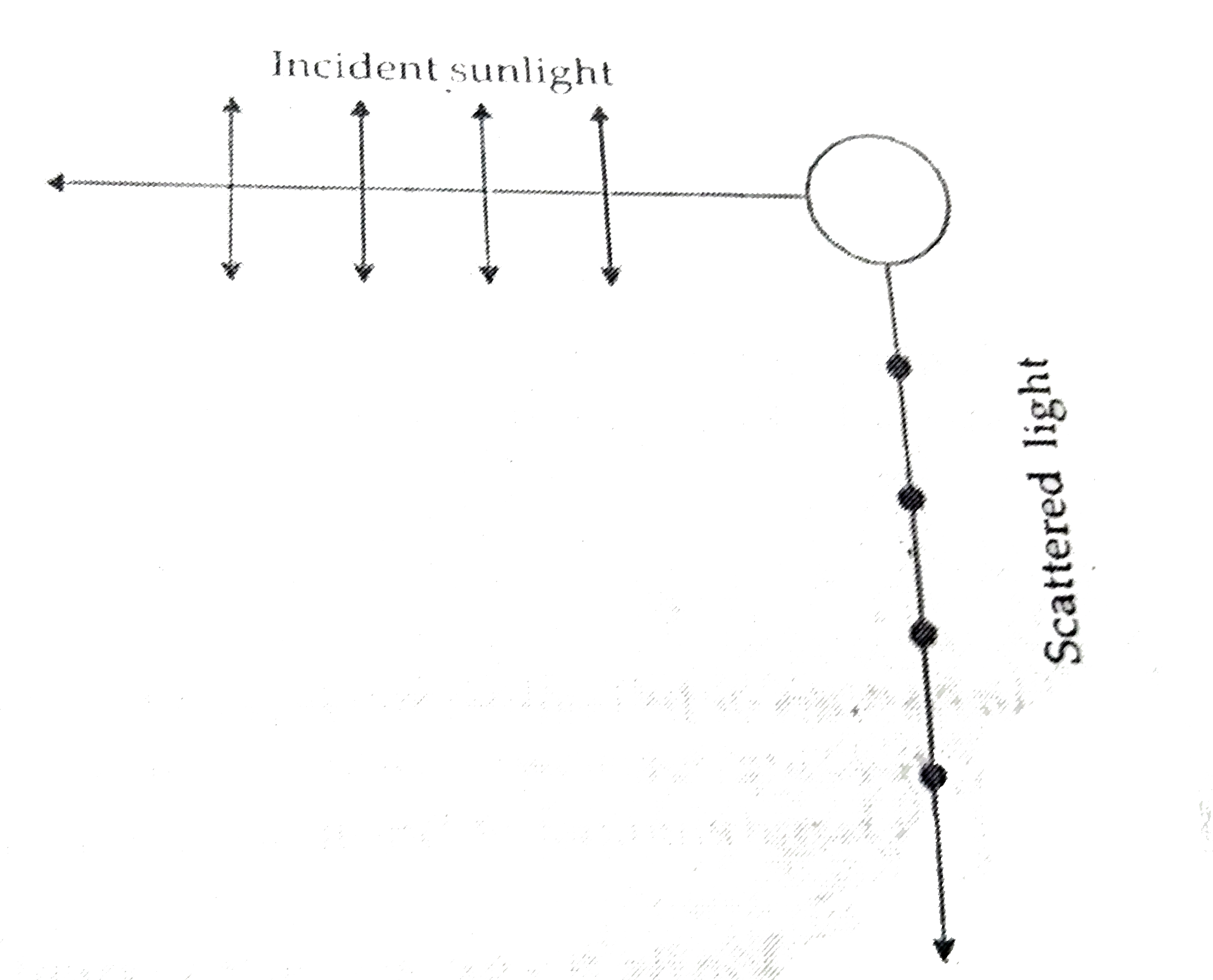(a) What is linearly polarized light ? Describe briefly using a diagram how sunlight is polarised.
(b) Unpolarised light is incident on a polaroid. How would the intensity of transmitted light change when the polaroid is rotated?
(a) Natural light is unpolarised i.e., the electric vector takes all possible directions in the transverse plane, rapidly and randomly, during a measurement. A polarizer transmits only one component. This resulting light is called linear or plane polarized.
The incident sunlight is unpolarised. The dot and double arrows show the polarization in the perpendicular and in the plane of the figure. Under the influence of the electric field of the incident wave, the electrons in the molecules of the atmosphere acquire components of motion in both these directions. An observer looking at to the direction of the sun, the charges accelerating parallel to the double arrows do not radiate energy towards theis observer since their acceration has no transverse component. The radiation scattered by the molecule is therefore represented by dots. It is linearly polarized perpendicular to the plane of the figure.

(b) If the unpolarised light is incident on a polaroid, the intensity is reduced by half. Even if the polaroid is rotated by angle the average over . Thus, from Malus' Law : I =
Or
Thus, the intensity of the transmitted light remains unchanged when the polaroid is rotated.
Topper's Solved these Questions
- XII BOARDSBOOK - XII BOARDS PREVIOUS YEARCHAPTER - XII BOARDSEXERCISE - SET-II
35 Videos
- XII BOARDSBOOK - XII BOARDS PREVIOUS YEARCHAPTER - XII BOARDSEXERCISE - SET-III
25 Videos
- XII BOARDSBOOK - XII BOARDS PREVIOUS YEARCHAPTER - XII BOARDSEXERCISE - SET III
9 Videos
- SAMPLE PAPER 2019BOOK - XII BOARDS PREVIOUS YEARCHAPTER - SAMPLE PAPER 2019EXERCISE - SECTION D
6 Videos
Similar Questions
Unpolarised light of intensity I is incidnet of the polaroid. What will be the intensity of light transmitted by the polaroid?
View SolutionA partially plane polarised beam of light is passes thorugh a polaroid. Show graphically the variation of transmitted light with angle of rotation of polaroid.
View Solution
Knowledge Check
When an unpolarised light of intensity I0 is incident on a polarising sheet, the intensity of the light which does not get transmitted is
AzeroBI0C12I0D14I0Two polaroids are crossed. If one of them is rotated through 30∘ and unpolarised light of intensity l0 is incident on the first polaroid, then the intensity of transmitted light will be
Al04B3l04C3l08Dl08Two polaroids are crossed. If now one of them is rotated through 30∘ and unpolarised light of intensity l0 is incident on the first polaroid, then the intensity of transmitted light will be
Al04B3l04C3l08Dl08
Discuss the intensity of transmitted light when a polaroid sheet is rotated between two crossed polaroids?
View SolutionDisuss the intensity of transmitted light when a polaroid sheet is rotated between two crossed polaroids ?
View SolutionTwo polaroids are crossed. If now one of them is rotated through 30∘ and unpolarised light of intensity l0 is incident on the first polaroid, then the intensity of transmitted light will be
View Solution(a) Distinguish between unpolarized light and linearly polarized light. How does one get linearly polarised light with the help of a plaroid ?
(b) A narrow beam of unpolarised light of intensity I0 is incident on a polaroid P1. The light transmitted by it is then incident on a second polaroid P2 with its pass axis making angle of 60∘ relative to the pass axis of P1. Find the intensity of the light transmitted by P2.
View Solution(a) Distinguish between unpolarized light and linearly polarized light. How does one get linearly polarised light with the help of a plaroid ?
(b) A narrow beam of unpolarised light of intensity I0 is incident on a polaroid P1. The light transmitted by it is then incident on a second polaroid P2 with its pass axis making angle of 60∘ relative to the pass axis of P1. Find the intensity of the light transmitted by P2.
View Solution
